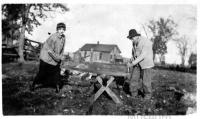OVER the hill to the poor-house I’m trudgin’ my weary way—,
I, a woman of seventy, and only a trifle gray—,
I, who am smart an’ chipper, for all the years I’ve told,
As many another woman that’s only half as old.
Over the hill to the poor-house—I can’t quite make it clear!
Over the hill to the poor-house—it seems so horrid queer!
Many a step I've taken a-toilin’ to and fro,
But this is a sort of journey I never thought to go.
The story from the above 1872 Will Carleton poem “Adversity” was once a common tale for those living with poverty or disability in America. Anyone who could not find self-supporting work – due to age, physical or mental disability, dependent children, or other factors – and who had no family to care for them would find themselves facing the prospect of the poorhouse. Originating in the United Kingdom, poorhouses were institutions designed to employ the poor and disabled in exchange for food, housing and healthcare. As the British Empire spread, so did its ideologies; Colonial America’s larger cities featured poorhouses and, as the Union formed and expanded, so followed poorhouses or – as was more common in the U.S. – poor farms. County governments in each state oversaw poor farms where residents, then referred to as “inmates”, were expected to complete farm labor and housework for room and board.
By the early 20th century, most Kansas counties had a poor farm. Johnson County’s poor farm was built on a 160-acre plot at the corner of what is now 119th Street and Ridgeview Road in Olathe. While its specific origin date is unclear, it opened in the mid-1860s with 8 residents working the farm. With the assistance of a small staff, they grew corn, oats, black sorghum, hay potatoes, cow peas and apples. They raised hogs, cows and chickens. During its tenure, the farm housed an average of 15-40 residents, though times of widespread hardship saw higher numbers.
In 1909, a visiting representative from the Olathe Mirror newspaper described the farm as clean, well-furnished and comfortable. Of its then twelve residents, it was said: “Some of these are too aged to be of any assistance and three of them are blind, so that as a whole, the inmates instead of being a help either on the farm or in the infirmary, must be helped.” This was true for many farms across the country. The circumstances leading people to poor farms often made them unsuitable for the hard labor of farm work. Over time, many county-appointed superintendents found it more financially viable to rent their farmland out, using the proceeds to provide for their residents, rather than rely on them for farm output.
As management for poor farms was largely unregulated, quality of life varied greatly among different counties and states. Some superintendents received salaries while others made only what the farm earnings would allow. Ideologies differed too, on what poor farms were designed for, with some treating them as purely charitable ventures while others sought high profits – leading many residents to experience mental and physical abuse, overwork and unclean and inadequate surroundings. Residents of poor farms sometimes shared one razor, toothbrush and wash basin among themselves. Unsurprisingly, disease spread quickly in these places. To justify such conditions, superintendents would claim they did not want to provide what they saw as luxury items, believing that providing comforts would prevent residents from wanting to leave poor farms – but most never had the ability to leave, regardless of want.
Poor farms were ubiquitous for over a century in the United States, but population and economic changes made the already shaky system untenable in the first half of the 20th century. The 1929 economic crisis that ushered in the Great Depression led to overwhelming need for poor relief. Poor farms lacked funding to care for their already existing residents and were unable to take on further economic burdens. By 1933 almost one-third of all Kansas farmland was tax delinquent, and the country was in crisis. In 1935 Congress created the Social Security Act and, with it, federal financial support for the elderly, disabled, dependent mothers and children, and unemployed. These changes, along with a series of housing reforms, allowed many who would have faced poor farms to live independently. Three years later, nearly a third of all Kansas poor farms had been repurposed or closed entirely.
As methods of social relief changed, so did public opinion. Poor farms were increasingly viewed as inhumane and outdated, and public thought turned toward newer institutions designed to provide for people on an individual level – nursing homes, mental health facilities and schools for deaf and blind students. Many former Kansas poor farms were converted to nursing homes, community centers and hospitals. Operating through the end of World War II, the Johnson County Poor Farm became a senior care facility before the land was repurposed for government use. Gone but not entirely forgotten, the plot where the farm once stood still provides services to the county’s many residents; it now houses the Johnson County Department of Health and Environment, MED-ACT and the K-State Research and Extension Office.
-Sam S., Johnson County Library

